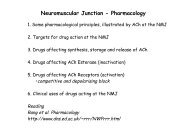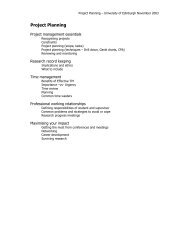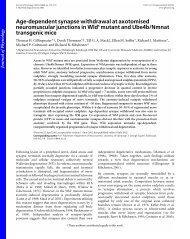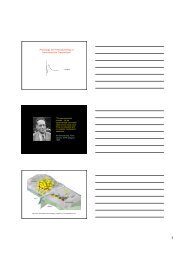Lecture 4: Neuromuscular Junction: Pharmacology
Lecture 4: Neuromuscular Junction: Pharmacology
Lecture 4: Neuromuscular Junction: Pharmacology
You also want an ePaper? Increase the reach of your titles
YUMPU automatically turns print PDFs into web optimized ePapers that Google loves.
Neuroscience with <strong>Pharmacology</strong> 2<br />
<strong>Neuromuscular</strong> <strong>Junction</strong> 2: <strong>Pharmacology</strong><br />
Sir Henry Dale<br />
Acetylcholine<br />
+ <br />
“Quaternary” nitrogen<br />
1
Terminal<br />
Schwann Cell<br />
Synaptic vesicles<br />
Motor nerve<br />
terminal<br />
Mitochondria<br />
Active<br />
Zone<br />
Kranocyte<br />
Motor<br />
endplate<br />
PSD<br />
Basal<br />
Lamina<br />
<strong>Junction</strong>al<br />
Folds<br />
Neurotransmitters are released by exocytosis from synaptic vesicles<br />
2
Excitation synchronises neurotransmitter release<br />
S<br />
End-Plate Current (EPC)<br />
End-Plate Potential (EPP)<br />
20 mV<br />
2 ms<br />
Quantal analysis of EPPs shows a “safety factor” of 2-5<br />
Actual m !<br />
Threshold m !<br />
3
Targets in neuromuscular pharmacology :<br />
® <br />
® <br />
® Synthesis<br />
® Storage<br />
® Release<br />
® <br />
® <br />
® <br />
® Action<br />
® Inactivation<br />
<strong>Neuromuscular</strong> <strong>Junction</strong> - <strong>Pharmacology</strong><br />
1. Principles and methods of studying ACh pharmacology at<br />
the NMJ<br />
2. Targets for drug action (synthesis, storage, release,<br />
action, inactivation)<br />
3. Drugs affecting postsynaptic (nicotinic) ACh Receptors<br />
Twitter: #NeuroMJ<br />
@RRibchester<br />
4
Drugs acting at the NMJ are useful as:<br />
w Experimental tools<br />
w Clinical treatments<br />
Several techniques can be used to assay the<br />
effects of drugs at NMJ’s<br />
1. Muscle contraction<br />
2. Intracellular EPP recording<br />
3. Iontophoresis/patch clamp<br />
4. Ligand binding<br />
5
Measuring muscle contractions in response to<br />
release of neurotransmitter by nerve<br />
stimulation….<br />
dTC dTC neo sux sux sux neo direct <br />
6
Measuring EPP’s….<br />
X <br />
Action potential<br />
…add µ-conotoxin<br />
…add d-tubocurarine<br />
…Reduce Ca 2+ and/or add Mg 2+<br />
EPP’s<br />
(muscle action potential blocked)<br />
EPP’s in low Ca/high Mg<br />
Mg 2+ <br />
Ca 2+ <br />
5 mV<br />
10.00 ms<br />
5 mV<br />
10.00 ms<br />
7
Transmitter release (EPP amplitude; Quantal content) depends on [Ca 2+ ] 4<br />
Mg 2+<br />
Slope=4<br />
Dodge & Rahamimoff (1967) JPhysiol<br />
Na + <br />
Ca 2+ <br />
K + <br />
8
Ch.2<br />
2 mV<br />
30.00 ms<br />
Inhibiting and Enhancing ACh Release: Ca/K-dependent<br />
0 Ca Direct +Ca +4AP +Mg +4AP Direct TTX <br />
Testing drugs on ACh receptors<br />
Iontophoresis<br />
I <br />
10 µM ACh<br />
2 mV<br />
60 s<br />
Bath application<br />
s<br />
V <br />
Patch clamp<br />
9
Drug assays at the NMJ are based on:<br />
w Biological response (->efficacy, EC50)<br />
w Ligand binding (->affinity, K D )<br />
EC 50<br />
10
Ligand binding visualised…<br />
Control <br />
α-bungarotoxin <br />
10µm α-BTX!<br />
But normally measured chemically (eg radioactively-labelled ligand)…<br />
11
General scheme for Agonist-Receptor Interaction<br />
(illustrated by ACh binding to its Receptors)<br />
ACh + R D ACh-R D ACh-R*<br />
bound activated<br />
D<br />
D<br />
ACh-R 0<br />
“desensitized”<br />
[ACh].[R]<br />
K D = = ~ 80 µM<br />
[ACh-R]<br />
2. Targets for drug action at the NMJ<br />
- Presynaptic<br />
- Intrasynaptic<br />
- Postsynaptic<br />
Twitter: #NeuroMJ<br />
@RRibchester<br />
12
Choline acetyltransferase Inhibitor<br />
X <br />
AF64A<br />
Drugs that inhibit transmitter synthesis/storage<br />
Choline uptake <br />
Hemicholinium-3<br />
x <br />
x <br />
Vesicle filling <br />
Vesamicol<br />
13
Drugs that inhibit transmitter release<br />
P/Q Ca 2+ channel blockers<br />
Botulinum toxins = ‘SNARE’ blockers<br />
ω-agatoxin/<br />
ω-conotoxin<br />
Ca 2+ <br />
x <br />
x <br />
Latrotoxin enhances transmitter release<br />
α-latrotoxin <br />
BEFORE <br />
During <br />
AFTER <br />
14
Drugs that block ACh esterase<br />
Acetylcholine<br />
Edrophonium<br />
Neostigmine<br />
Sarin<br />
x <br />
Antidote: Pradiloxime<br />
Anticholinesterases prolong EPPs<br />
Control<br />
C h . 0<br />
C h . 0<br />
C h . 0<br />
5 m V<br />
5 . 0 0 m s<br />
5 m V<br />
5 . 0 0 m s<br />
5 m V<br />
5 . 0 0 m s<br />
Neostigmine (5 µM)<br />
15<br />
Half Decay Time<br />
Hepes Buffered Ringer Solution<br />
Neostigmine (5µM)<br />
C h . 0<br />
Time (mS)<br />
10<br />
5<br />
0<br />
T1 T2 T3 T4<br />
EPP Train Number<br />
5 m V<br />
5 . 0 0 m s<br />
15
3. Drugs affecting postsynaptic (nicotinic) ACh Receptors<br />
Twitter: #NeuroMJ<br />
@RRibchester<br />
The nicotinic ACh Receptor at NMJ<br />
8 nm<br />
/ε <br />
16
nACh Receptor <strong>Pharmacology</strong> - <strong>Neuromuscular</strong> <strong>Junction</strong><br />
Agonist Antagonist/blocker<br />
nicotine<br />
d-tubocurarine (curare)<br />
acetylcholine α-bungarotoxin<br />
carbachol atracurium<br />
decamethonium<br />
pancuronium<br />
suxamethonium (I) suxamethonium(II)<br />
17
Atropine <br />
d-Tubocurarine <br />
Drugs that block ACh Receptors (antagonists)<br />
Reversible<br />
Example:<br />
d-tubocurarine<br />
Irreversible<br />
Example:<br />
α-bungarotoxin<br />
18
ACh<br />
Na + <br />
ACh<br />
dTC<br />
dTC ACh<br />
K + <br />
19
ACh<br />
ACh<br />
ACh<br />
ACh<br />
dTC ACh<br />
dTC<br />
Na + <br />
ACh<br />
K + <br />
20
ACh<br />
Na + <br />
ACh<br />
αBTX<br />
αBTX ACh<br />
K + <br />
21
ACh<br />
ACh<br />
ACh<br />
ACh<br />
ACh<br />
ACh<br />
ACh<br />
ACh<br />
αBTX<br />
ACh<br />
Suxamethonium<br />
Acetylcholine<br />
2 <br />
2 <br />
Not broken down by AChE (nmj)<br />
Broken down by BuChE (blood plasma)<br />
Short lasting<br />
Not counteracted by cholinesterase inhibitor<br />
Used clinically for brief muscle relaxation<br />
“Depolarising blocker”<br />
22
dTC dTC neo sux sux sux neo direct <br />
Sux <br />
Na + <br />
Sux <br />
K + <br />
23
Na + <br />
Na + <br />
Sux <br />
+ + <br />
K + <br />
Na + <br />
Na + <br />
Sux <br />
+ <br />
+ <br />
K + <br />
24
Na + <br />
Na + <br />
Sux <br />
+ <br />
K + <br />
Sux <br />
Na + <br />
Sux <br />
K + <br />
25
Targets of drug action at the neuromuscular junction<br />
vesamicol<br />
botulinium (A-D)<br />
hemicholinium<br />
α-bungarotoxin<br />
d-tubocurarine<br />
atracurium<br />
suxamethonium<br />
edrophonium<br />
neostigmine<br />
sarin<br />
Tweets from<br />
#NeuroMJ<br />
26
Summary<br />
1. Every step in the cycle of ACh synthesis, storage, release, activation and inactivation<br />
is a potential target for drug action at the NMJ.<br />
2. Drugs affecting storage and synthesis :<br />
• AF64A, hemicholinium, vesamicol<br />
3. Drugs affecting release<br />
• 4-AP, α-latrotoxin, botulinum toxin, ω-agatoxin,<br />
• Mg 2+ , botulinum toxin, ω-agatoxin, 4-AP, α-latrotoxin,<br />
4. Drugs that block ACh Esterase:<br />
• edrophonium, neostigmine, sarin<br />
5. Drugs affecting ACh Receptors:<br />
• carbachol, decamethonium, suxamethonium<br />
• tubocurarine, α-bungarotoxin, atracurium<br />
6. Clinical uses of drugs acting at the NMJ:<br />
• muscle relaxants as adjunct to anaesthesia in surgery<br />
• treatment of neuromuscular disease<br />
27








